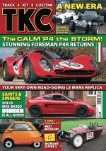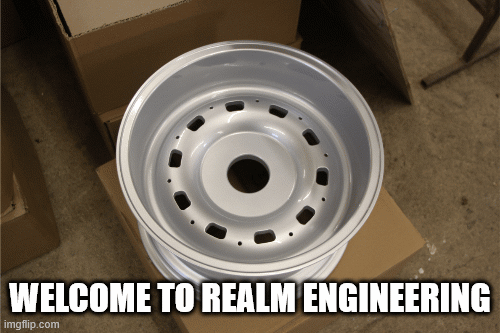
STEVE HOLE TELLS THE STORY OF THE COX/GTM COUPÉ
Initially known as the Cox Grand Touring Mini the car was designed by Jack Hosker and productionised by Cheshire garage owner, Bernard Cox, in 1967. The latter ran Renault dealer, Cox & Co (Manchester), as well as a petrol station across the road.
Cox raced an Elva Courier at national level in the late fifties often against his good friend and employee, Jack Hosker, who worked as a manager for Cox.

The Cox family owned several businesses including a posh department store in Wilmslow called Finnigans. However, Bernard had always wanted his own car and tasked Hosker with designing it. It was built in the service bay of Cox’s petrol station.
Famously, the chassis model was made from cornflake packets. It was the first mid-engined kitcar. Putting the engine behind the occupants solved one of the Mini’s inherent problems – its height and, the GTM, as well as being pretty, was a very capable little car.
Based around a steel box section chassis, with modified Mini front sub-frames, front and rear and a GRP body, it was launched at the Racing Car show of January 1967 with a kit price of £330 (approximately £3850, today).
Cox didn’t want any corners to be cut and demanded high quality and farmed out the fabrication of the chassis and also body production (GRP is smelly and messy, after all). However, he had no control over quality and some of the stuff he brought in wasn’t up the standard that he required.
The customer would receive his kit with the body pre-fitted and the doors pre-hung, but they needed to be very handy with a toolkit as it wasn’t an easy build. No chassis jig existed nor a build manual, while the GRP was said to be of poor standard.
There was also an issue with the windscreens produced by Tudor Glass (later Pilkington Glass) on the Isle of Sheppey. There had been a mistake in making the template for the windscreen shape that was cut out of the body. It was too small and the ‘screens would crack for fun.
It gained good press due to its fine handling but Cox was becoming bored with the car and had done what he’d set out to do. Cox & Co went bust in February 1969 after selling 55 kits.
Handy Formula Three driver, Howard Heerey, whose father ran Ford dealership Midland Garage of Buxton Road, Hazel Grove, had been doing some competition driving for Cox and took over the project.
He came up with a revised chassis also adding a supporting frame for the engine, raising kit price to £350, at the same time. He also made further alterations to the interior and some subtle styling mods such as adding a Mini front bumper and revised indicators, re-naming the car the GTM 1-3. Heerey sold a further 155 before his operation went into liquidation. Cars & Car Conversions magazine built a Group 6 race version in 1970, incidentally.
That year also saw the revised GTM re-launched at the BRSCC’s Specialist Sports Car Show in London’s Old Horticultural Halls. The Racing Car Show was held bi-annually and the intervening years would see other events held to fill the void.
Heerey’s his intention/ambition was to only supply fully built cars, although when ex-Standard Triumph designer (he had input in the TR3), Alex Dick joined him, he decided to continue to offering kits.
His adverts of the period described the GTM 1-3 thus: “…mid-engined like a Lamborghini; good-looking like a Ferrari, beautifully engineered from the best materials, roomy, fast, economic and, in fact, a proper GT car.” Fully built versions were known as the Heerey GTM.
The ‘1-3’ was a big under-the-skin revamp and the car was lower and wider featuring a revised nose, new grille and blended-in Mini bumper with Triumph Dolomite rear light lenses. The original’s rear subframe was replaced by a sheet metal structure.
An ambitious move to a 20,000sq/ft purpose-built factory never materialised, mainly due to promised finance not arriving, which also did for his company, too in March 1972. By the time Heerey was done, he’d sold around 70 GTMs.
HE Glass-Fiber took over from Heerey in June 1972 (ironically they’d earlier pitched for Heerey’s glassfibre work) although never made a car in the four years in charge (word is that they didn’t know how to build a car) that they had the project, likewise the next custodians, KMB, run by Mike Smith.
One day, Peter Beck was at KMB trying in vain to buy spares for the Coupé that he owned. Impressed by the car, he soon bought the project along with friends Paddy Fitch and Douglas Cowper. The latter left shortly after.
The newly formed GTM Cars, revised the car by adding a bigger front spoiler, widened the wheel arches, the rear end now incorporated a GRP bumper rather than have a separate item along with new light lenses, too. While at it, they added a sunroof, BL door handles and a new interior. GTM under Beck and Fitch went on to sell around 600 units.
With the launch of their new Rossa model in 1995, the Coupé was sold to Peter Leslie of Primo Designs of Stoulton, Worcestershire who worked hard at making the car SVA compliant such as moving the headlights back 3in. Sadly, he did very little with the project.
Cox & Co 1967-69
Howard Heerey Engineering Ltd 1969-72
HE Glass-Fiber of Hartlepool 1972-76
GTM Cars (part of KMB Autosports) Wellingborough 1976-80
GTM Cars 1980-95
Primo Designs 1995-01
Approx 700 made











